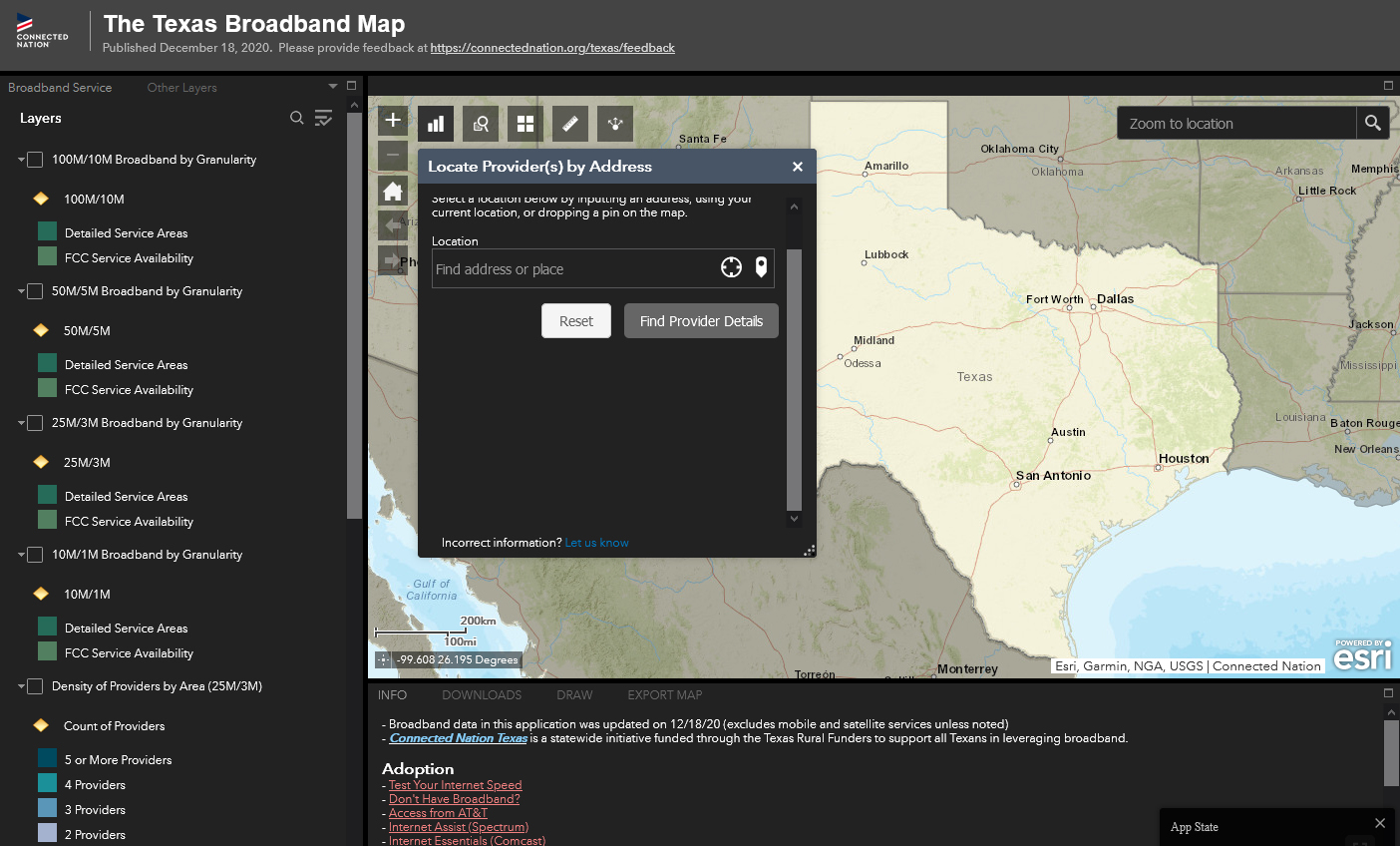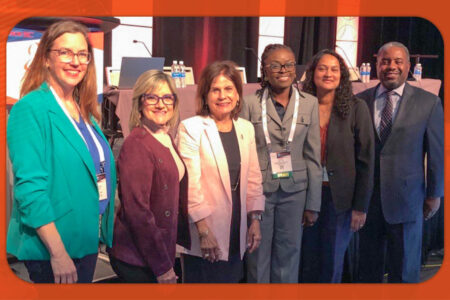
Share On Social!
Updated broadband coverage maps for all 254 counties in Texas highlight that many Texans lack the digital infrastructure needed for high speed, stable internet, particularly in rural areas and communities of color, according to Connected Nation Texas.
“To close the Digital Divide in Texas, we need accurate data on where Texans are connected and where they lack basic infrastructure to participate in the digital world,” said Ellen Ray, Chair of Texas Rural Funders, which supported Connected Nation Texas in producing the maps, according to a press release. “The future of Texas education, healthcare, and economic development will depend on all Texans having the ability to access high-speed internet.”
Lack of access to high-speed internet is especially prevalent in rural Latino communities. This leads to families disconnected from online learning material and telehealth resources.
Fortunately, several bipartisan bills in the Texas Legislature are currently underway to being passed to improve broadband access.
What Do the Connected Nation Broadband Maps Show?
Connected Nation is a nonprofit that aims to expand access to and increase the adoption of broadband high-speed internet for everyone.
Their Texas division worked to produce these maps, which found:
- Over 315,000 households remain unserved at 25×3 speeds, the minimum download speed that the FCC defines as broadband.
- 28 counties have less than half of their households served by 25×3 broadband.
- Rural availability drops significantly as speeds increase, especially compared to overall Texas availability.
- Overall availability decreases from 96.5% at 25×3 speeds to 88.6% at 100×10 speeds.
- For rural areas, availability decreases from 90.3% at 25×3 speeds to 68.9% at 100×10 speeds.
The Connected Nation report is consistent with others ─ like the Texas Black Caucus Foundation and The University of Texas Law School Civil Rights Clinic’s joint Planning for Digital Inclusion in Texas report─ that indicate rural, low-income communities of color face barriers to high-speed internet adoption.
“[The report] highlighted the need for including strategies designed to overcome barriers to adoption for those that are being left behind by the Digital Divide—low-income rural and urban communities, people of color, older adults, and people with disabilities in the state’s broadband strategy.The report provides data that supports their assertions about the Digital Divide and its impact on disadvantaged communities that is consistent with many other reports,” said Heather Gate, Vice President of Digital Inclusion at Connected Nation, in an email.
 When using the interactive maps, users can see which Texas counties face internet disparities.
When using the interactive maps, users can see which Texas counties face internet disparities.
For example, here is some data comparing a majority white, urban county and majority Latino, rural county:
Duval County, TX
- Population: ~11,000
- 89% Latino
- Percentage of households with access to high speed internet: 72.6%
Tarrant County, TX
- Population: ~2.1 Million
- 29% Latino
- Percentage of households with access to high speed internet: 99.9%
Gaps in internet infrastructure often affect predominately rural communities and communities of color and can have negative impacts on Latinos.
How Does Lack of Broadband Affect Latinos?
The digital divide, or a lack of internet access that disproportionately affects some groups, can lead to disconnected families.
This has been especially worrisome during the COVID-19 pandemic, as schools have shifted to online or hybrid virtual and in-person learning.

According to research from Latino Decisions and Abriendo Puertas/Opening Doors, Latino parents have several concerns about how internet access affects their children’s education.
Key survey findings state:
- 33% of Latino families do not have regular access to the internet, 37% only have access from cell phones
- 58% of Latino parents feel online schoolwork has been difficult because of technical problems, such as websites or programs not working
- 51% of Latino parents find their internet and/or cell phone bill is much higher now because increased usage is needed for online school.
- 50% of Latino parents do not have enough computers, laptops, or tablets for everyone in the household.
Latinos in rural areas of Texas have felt the digital divide especially.
“Rural communities often don’t have near the funds or the resources as your more urban communities,” said Debbie Bresett, the executive director of the nonprofit Bastrop County Cares, according to the Texas Observer.
In addition to education, rural access to telehealth care is impacted by poor internet availability.
“Lack of connectivity can hinder the implementation and expansion of telehealth programs that require live-video connections between patients and providers. Dropped calls and delays in video feeds can interrupt care delivery and lead to patient dissatisfaction with telehealth,” according to the Rural Health Information Hub.
Lack of access to telehealth resources have especially impacted Latinos and other people of color, who have also been disproportionately hurt by COVID-19.
“Patients face three overlapping barriers to accessing telehealth: the absence of technology, digital literacy, and reliable internet coverage. Together, these barriers comprise the digital divide, which disproportionately affects older people of color and those with low socioeconomic status. These obstacles are even more insurmountable at a time when doctors are closing their outpatient clinics and delivering care exclusively from their homes, using computers or smartphones to contact their patients through video or phone calls,” according to Health Affairs.
What is Texas Doing to Stop the Digital Divide?
Thankfully, Texas legislators are making strides to improve broadband access to rural areas.
Last month, the Texas Senate unanimously passed Senate Bill 5, a measure to expand broadband infrastructure.
“It establishes a baseline state-level policy plan and infrastructure, that when we receive federal funds, and the state appropriates funds, and the private sector can get engaged, it will allow us to solve the problem,” said Robert Scott, a founder of the Texas Rural Broadband Coalition, according to the Texas Standard.
Other bills to expand telehealth and broadband access across Texas have been passed in the House committee and are still being discussed in the Senate.
Due to the bipartisan support of increasing broadband access, the bills are likely to pass.
After a February 2021 snowstorm highlighted many inequities in Texas, Governor Greg Abbott prioritized increasing broadband access.
As broadband access increases, more is done to address health and education inequities.
“We MUST ensure that broadband infrastructure is universally available in Texas by addressing the challenges primarily seen in rural Texas. We MUST ensure that we eliminate barriers for all Texans to adopt high-speed internet – this includes rural and urban low-income households, school-age children, older adults, BIPOC (Black, indigenous, and people of color) households, and people with disabilities – the most disconnected Texans today,” said Gate, according to her email.
As we await more policies to increase broadband access and address inequities, we can do our part to advocate for Latinos and for health equity for all people.
You can help by downloading the Health Equity Report Card from Salud America!
The report card allows you to see what access your community has to healthcare, food, education, and other resources. You can help advocate for your neighbors and present the Health Equity Report Card to your city’s leadership!
By The Numbers
142
Percent
Expected rise in Latino cancer cases in coming years



